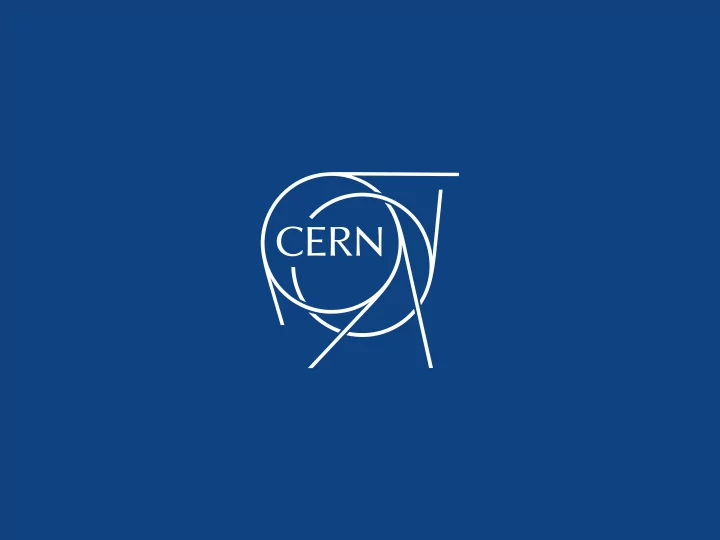

The surface impedance of Nb/Cu coated QWR cavities for HIE-ISOLDE project Silvia Teixeira K. Artoos, A. Miyazaki, G. Rosaz, K.Schirm, A.Sublet, M. Therasse, W.Venturini Delsolaro
Outline • HIE-ISOLDE Project • Quarter-Wave Resonator (QWR) • Cavity Performance • Rs0 and Rs1 • Features • Optical Inspections • Material Studies • New Cavity Design • Conclusions Thin Film Workshop ‘16 Silvia Teixeira 3
HIE-ISOLDE • The High Intensity and Energy ISOLDE (HIE-ISOLDE) project is a major upgrade of the existing ISOLDE and REX-ISOLDE facilities. • Energy increase of the delivered radioactive ion beam (RIB) from 3 MeV/u to 10 MeV/u. • SC LINAC based on Quarter Wave Resonators (QWRs). • High- β section consists on 4 cryo- modules with 5 cavities each. Beam direction Thin Film Workshop ‘16 Silvia Teixeira 4
Quarter Wave Resonator (QWR) • Superconducting Nb-film cavity at 4.5 K L 4 He (4.5K) • Conduction cooling through the copper substrate (good E-field thermal conductivity of Cu) • DC bias sputtering system • Welding in the high magnetic field region Surface resistance 𝑺𝒕 has non-trivial behavior • Conduction Frequency 101.28 MHz cooling H-field E acc 6 MV/m β optimum 10.9% 553 Ω R/Q E peak /E acc 5.4 B peak /E acc 96 G/(MV/m) Beam axis 30.34 Ω G=R s Q 2 0.207 J/(MV/m) 2 U/E acc P c at 6MV/m 10W Thin Film Workshop ‘16 Silvia Teixeira 5
Cavity Performance Raw data Thin Film Workshop ‘16 Silvia Teixeira 6
Presented by Pei in 2014 Thin Film Workshop ‘16 Silvia Teixeira 7
Cavity Performance Ideal thermal gradient Thin Film Workshop ‘16 Silvia Teixeira 8
Cavity Performance Ideal thermal gradient Thin Film Workshop ‘16 Silvia Teixeira 9
Temperature dependent component BCS fit at low field Thin Film Workshop ‘16 Silvia Teixeira 10
Rs0 and Rs1 to evaluate the cavity Low-field Q-slope Linear fit: Rs( 𝐹 𝑏𝑑𝑑 ) = Rs0 + Rs1 • 𝐹 𝑏𝑑𝑑 (0< 𝐹 𝑏𝑑𝑑 <3 MV/m) Q-slope Thin Film Workshop ‘16 Silvia Teixeira 11
Rs1 vs Rs0 for all cavities Ideal thermal gradient • Rs0 and Rs1 are weakly but positively correlated (correlation factor 0.3) Thin Film Workshop ‘16 Silvia Teixeira 12
Optical Inspections • In most of the substrates of the series production, cracks were observed mainly near the weld area (in the outer conductor) • In most cases they are identified when revealed by the SUBU (chemical treatment) Thin Film Workshop ‘16 Silvia Teixeira 13
Optical Inspections Thin Film Workshop ‘16 Silvia Teixeira 14
Rs1 vs Rs0 for all cavities cracks • Rs0 and Rs1 are weakly but positively correlated (correlation factor 0.3) • The substrate with the cracks tends to have higher Rs1 (Q-slope) • Removal of the smoothing weld for material investigations Thin Film Workshop ‘16 Silvia Teixeira 15
Material Studies • Linear indications (appearing as cracks and voids) at surface were observed after SUBU etching on QS9, especially around the EB weld zone. • Cracks are not only present in the surface, but in the bulk material (OFE copper). • SUBU doesn’t generate the imperfections, but reveals them. Courtesy of M. Crouvizier • Hydrogen embrittlement was discarded as a possible culprit. • We tried to reproduce the same effect on several kinds of OFE compliant material without succeeding . • Residual stresses and heat have probably contributed to the apparition of these imperfections. Thin Film Workshop ‘16 Silvia Teixeira 16
Seamless Cavity Major changes from previous design: L 4 He (4.5K) • Cavity machined from a bulk Cu cylinder . E-field • Antenna length shorter for frequency tuning • Thinner inner conductor to recover R/Q • Cone insertion to avoid leakage through the beam ports Frequency 101.28 MHz E acc 6 MV/m β optimum 0.12 H-field 525 Ω R/Q E peak /E acc 4.9 Beam axis B peak /E acc 98 G/(MV/m) 30.79 Ω G=R s Q 2 U/E acc 0.214 J/(MV/m)2 P c at 6MV/m 10 W Thin Film Workshop ‘16 Silvia Teixeira 17
Conclusions • A set of measurements of 17 HIE-ISOLDE Nb/Cu QWRs have been presented. • Part of the surface resistance has been explained by a BCS fit with ¨ reasonable ¨ parameters. • Rs0 and Rs1 are weakly but positively correlated . • There is a performance degradation with time on the production of the cavities. The increase in surface resistance looks correlated to the observed cracks at the weld of the Cu substrate. • The material studies concluded that residual stresses and heat might be the origin of the cracks. • A new design of a seamless cavity has been developed in order to avoid the EB welding of the substrate. Thin Film Workshop ‘16 Silvia Teixeira 18
Recommend
More recommend